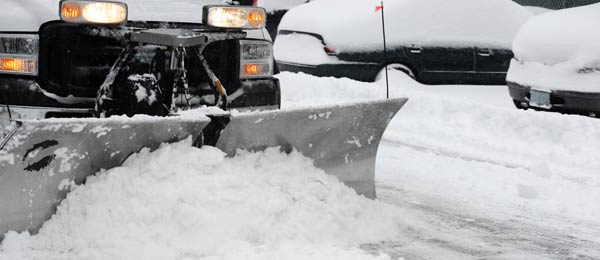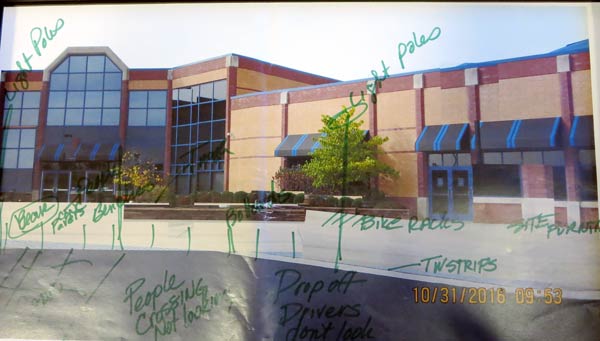
Elk Grove Park District Takes a “Scientific” Approach to Snow Plowing
With nine facilities and 42 parks, Elk Grove Park District has a lot of ground to clear once snow begins to fall. “Each parking lot has a unique configuration, so there are customized plowing plans to choreograph both plowing and piling snow,” explains Anita Healy, ARM, CPSI, Risk Manager and Safety Coordinator. “Each public walk and facility pathway poses unique challenges with tactile warning surfaces, utility boxes, bollards, statues, planters, bike racks and more.” As at other agencies, safe snow removal is a top priority at Elk Grove. Executive Director Tom Busby points out that “slip and fall accidents can be common during the winter months, but proper snow removal helps prevent them.”
Healy takes her cue for addressing snow issues from Deborah Herman, CEO of the National Safety Council, who cautions against getting complacent about things you see or do every day. “In other words, we need to stay vigilant,” Healy says. “As old hazards fade away, new hazards emerge.”
Bill, a mechanic at the agency, echoes that sentiment when he warns drivers about catch basins that snag the snow plow, “After plowing the same area 100 times, you think you’d remember exactly where that catch basin is. Yet, repeatedly, you find yourself getting rattled when you drive over it.”
Using her previous experience with activities like hazard identification and find-the-hazard photos, Healy created a unique solution to help drivers recognize dangers and plow safely.
Presenting the challenge

Rather than a dull presentation — or even a quiz — Healy created an activity in which she asked staff to be the experts in recalling potential hazards. Healy photographed various plowing locations that present unique challenges and used her computer to camouflage all the hazards. After dividing staff into groups, she gave each a different photo. Employees then drew in the plowing hazards on the poster-sized photos and presented their findings to the entire department. “This allowed members of each group to have a chance to be the expert and teach their coworkers,” she explains, “and that made everyone feel more comfortable about offering other precautions and suggesting techniques for effective snow removal in those challenging areas.”
Staff members ran with the idea and took pride in identifying the design challenges and landscape details that could impede snow removal or damage equipment if hit — such as speed bumps, drains, benches, bike racks, utility boxes, trash receptacles, cigarette stations and light poles. Valerie Lemme, Planner and ADA Coordinator, pointed out the exact dimensions of all the tactile warning strips on the walkways, noting that plowing those areas can damage the strips. Eliseo Vences, Irrigation Specialist, noted specific locations of uneven surfaces in the parking lot, sunken areas in sidewalks and spots in recently acquired property where asphalt is thin. Other issues staff identified were subtle elevation changes, uneven sewer covers and different surfaces along the same walking path. Another topic mentioned by managers was the concern about complacency due to the repetitive nature of the job task.
Rising to the challenge
Healy borrowed a second idea from TV crime shows to help engage staff in another training activity. She gave participants an incident summary, witness statements and photographs. Using those items, they answered questions, checked off various factors from a list and/or wrote down contributing causes to the accident based on the details and descriptions she provided.
“I told them they were CSI agents, and they had to bring keen eyes and sharp minds to the ‘accident scene’ to determine the contributing causes. They had to analyze the clues we gave them to prepare their version of how they thought the injury/damage happened.”
Stretching exercises
Casting a sharp eye on things didn’t end with CSI assessments. Aileen Tischauser, Personal Trainer, took a fresh look at day-to-day activities while watching her husband put on his socks one morning; it triggered an idea for a new approach to help snow crews remember to stretch.
“I thought about our snow crew on a cold, dark morning, getting ready for work just like my husband was. I realized there were ways they could gently waken their muscles, getting limber enough, so shoveling tasks didn’t stress their bodies.”
As a result, Tischauser created a stretching program that incorporated the movements of their daily dressing routine. “Even simple things like pulling on socks, tying boots or shrugging into a jacket can be the basis of exercises that warm up muscles to prevent injuries. Everyone has to get dressed for the weather anyway, so why not incorporate stretching exercises into the dressing routine and reap the benefits of warming up your muscles to prevent injuries?”
Elk Grove Park District’s snow plow training takes an interactive approach to help staff perform winter job tasks safely, avoiding incidents and injuries. |

